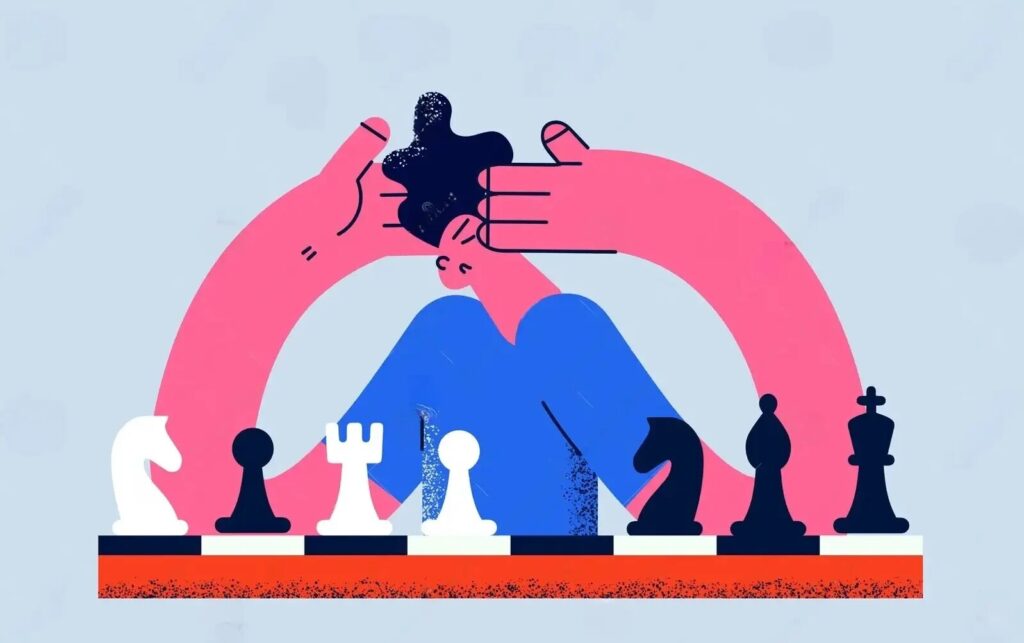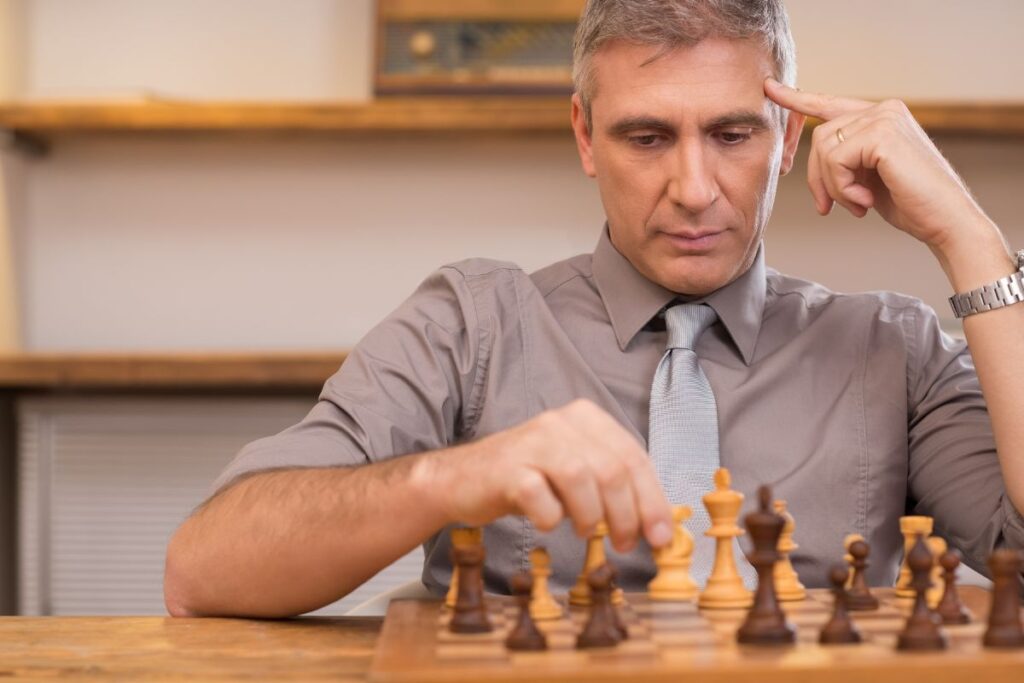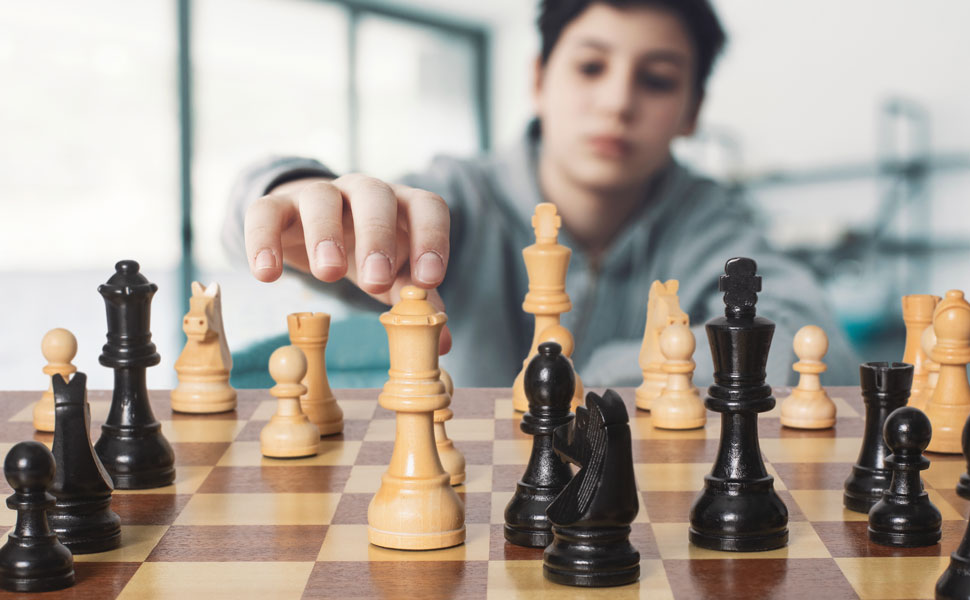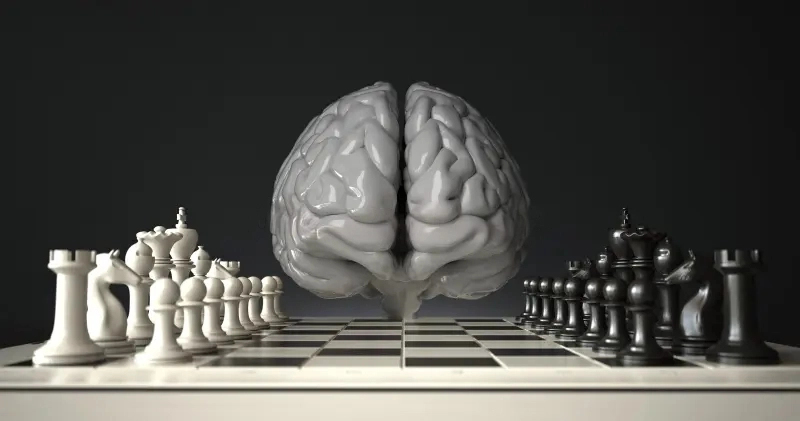Chess is often thought of as a purely logical and strategic game, but there’s much more to it than meets the eye. While it’s true that chess sharpens your ability to think analytically, it also stimulates creativity and imagination. In fact, playing chess engages both the left and right sides of the brain, making it an excellent tool for developing a balanced and well-rounded mind.
What Does Left and Right Brain Mean?
Before diving into how chess affects brain function, it’s essential to understand what we mean by “left-brain” and “right-brain” functioning.
These terms are often used to describe the different types of thinking associated with each hemisphere of the brain.
The left side of the brain is commonly associated with logical, analytical, and detail-oriented tasks. It’s where we process information sequentially, handle math problems, and think through step-by-step solutions.
In contrast, the right side of the brain is more creative and intuitive. It’s responsible for visualizing, thinking holistically, and understanding complex patterns.
Of course, no task in life involves just one side of the brain. Most activities require both hemispheres to work together, but certain activities emphasize one side more than the other.
Chess, however, is one of those rare activities that pushes both hemispheres to their limits.
How Chess Engages the Left Brain
Logical Thinking and Calculation
Chess is often seen as a game of pure logic, and that’s not far from the truth. To be successful at chess, you must think ahead, calculate moves, and anticipate your opponent’s strategies.
This type of logical thinking activates the left hemisphere of the brain.
When you play chess, your brain constantly analyzes the board. You think about how to protect your king, control the center, and plan your next moves.
This requires linear thinking—examining one possibility after another, calculating the consequences of each move. If you move your knight, what will your opponent do in response?
If they respond with their queen, what should you do next? This sort of step-by-step analysis is exactly the kind of process that exercises the left brain.
Pattern Recognition and Strategy
Pattern recognition is another critical aspect of chess that taps into left-brain functioning. Experienced players often see familiar patterns on the board, whether it’s a particular opening or a setup that leads to checkmate.
This ability to recognize patterns quickly allows players to make better decisions in the game.
The left brain helps you spot these patterns by analyzing the position of the pieces and identifying familiar sequences. Over time, chess players develop a mental library of moves, strategies, and counterstrategies, and their left brain helps them retrieve this information during a game.
Sequential Problem Solving
One of the core skills in chess is problem-solving. Chess is filled with mini-problems—each move presents a new challenge. Should you attack? Should you defend?
Should you sacrifice a piece to gain an advantage? Solving these problems requires a systematic approach, which is the hallmark of left-brain thinking.
In every chess game, players need to evaluate the current position and find the best solution. This process involves analyzing different possibilities one by one, eliminating poor choices, and settling on the most effective move.
This sequential problem-solving process is driven primarily by the left hemisphere, which excels at breaking down complex tasks into smaller, manageable parts.
How Chess Engages the Right Brain
While the left brain handles logic, calculation, and sequence, the right brain brings creativity, intuition, and visual thinking into the game. Chess isn’t just about cold, hard logic. It’s also about seeing the bigger picture, recognizing patterns, and thinking creatively to outmaneuver your opponent.
Let’s explore how chess activates and strengthens the right hemisphere of the brain.
Creative Problem-Solving
Chess is often referred to as an art form because it requires creativity. Players must come up with original solutions to unique challenges presented in every game.
While the left brain helps break down moves in a linear fashion, the right brain is responsible for coming up with those “aha!” moments when you discover a clever move or an unexpected tactic.
Creativity in chess isn’t just about finding surprising moves—it’s about thinking outside the box.
Sometimes, a move that looks weak on the surface can become a powerful advantage a few moves later. These creative insights rely heavily on the right brain, which allows you to visualize potential outcomes and think holistically about the board.
For example, sacrificing a valuable piece, such as a queen or rook, may seem counterintuitive. However, experienced players can sometimes foresee that giving up a piece will create a tactical opportunity later in the game.
This type of imaginative thinking exercises the right brain, which thrives on seeing things from a different perspective.
Visual-Spatial Awareness
Chess is a highly visual game. Players must constantly track the position of 32 pieces on a 64-square board.
But they also need to visualize future positions—imagining how the game will look several moves ahead. This ability to visualize not only the present but also future configurations of the board relies on the right hemisphere of the brain.
Visual-spatial awareness is the right brain’s specialty. When you’re playing chess, you’re not just reacting to what’s happening in the present moment. You’re imagining the possibilities—where pieces will be, how the board will look in 3 or 5 moves, and whether certain tactics will create opportunities down the road.
This type of spatial thinking strengthens the right brain’s ability to process complex visual information and understand how things fit together in space.
For children especially, strengthening this visual-spatial skill through chess can help in academic areas like geometry, where understanding how shapes fit together is essential.
It also benefits tasks such as reading maps, solving puzzles, or even learning how to play a musical instrument, all of which rely on strong spatial reasoning.
Intuition and Gut Instincts
While chess is a game of strategy and calculation, top players often talk about “feeling” when a move is right. This sense of intuition comes from the right brain, which processes information in a more holistic and non-linear way compared to the left brain.
While the left brain analyzes every detail, the right brain sees the bigger picture and sometimes arrives at a solution instinctively.
In chess, players might not always have time to calculate every possible move in detail. Instead, they rely on their intuition, built from years of experience, to guide their decisions.
This gut feeling often comes from recognizing patterns that the right brain has internalized, even if the player isn’t consciously aware of it.
The Perfect Balance: Left and Right Brain Working Together

Chess is unique in that it doesn’t just exercise one side of the brain—it strengthens both hemispheres simultaneously. While the left brain focuses on logic, analysis, and sequential thinking, the right brain engages in creativity, intuition, and visual-spatial processing.
This dual engagement is one of the reasons why chess is such a powerful tool for cognitive development.
Strategic Thinking: Merging Logic and Creativity
One of the most beautiful aspects of chess is the way it combines logical strategy with creative thinking. Every chess move requires a balance of both.
For example, a player might calculate several potential moves in a logical sequence (left brain), but then they might realize that an unconventional, creative move could lead to a surprising advantage (right brain).
Great chess players merge these two approaches. They can think several moves ahead, calculating risks and benefits, while also staying open to creative, unexpected moves that might catch their opponent off guard.
This ability to combine logic and creativity is one of the reasons chess players develop such well-rounded cognitive skills.
In life, this balance is equally important. Most problems we face—whether at school, work, or in our personal lives—require both logical analysis and creative solutions.
Chess provides a structured way to practice this kind of thinking, helping players develop a flexible mind that can tackle challenges from multiple angles.
Decision-Making: Fast and Efficient
Chess sharpens the ability to make decisions under pressure. When playing a timed chess game, players don’t always have the luxury of deeply analyzing every move.
Instead, they rely on both quick calculations and gut instincts. The left brain might help the player quickly calculate the safest move, while the right brain offers an intuitive sense of where the game is headed.
This balance of fast, efficient decision-making is critical in real-life situations. Whether you’re faced with a split-second decision at work or trying to solve a problem at home, the ability to quickly merge logic and intuition can lead to better, more confident choices.
Adaptability and Flexibility
Chess also teaches adaptability. No game of chess ever unfolds exactly the same way, which means players must constantly adjust their strategies based on what their opponent does.
This requires both flexibility in thinking (a right-brain strength) and the ability to quickly reanalyze and shift strategies (a left-brain strength).
In many cases, a chess player will start with a plan, only to have it derailed by an unexpected move from their opponent. At this point, the player needs to adapt their approach, combining creativity to find new opportunities and logical thinking to calculate the best path forward.
This ability to pivot and think on your feet is a crucial life skill, whether you’re navigating challenges at school, work, or in relationships.
Cognitive Benefits of Strengthening Both Sides of the Brain

When both hemispheres of the brain are equally engaged and working in harmony, it results in a sharper, more balanced mind. Chess offers the perfect exercise for this dual brain activation, which translates into various cognitive benefits that extend far beyond the chessboard.
Enhanced Problem-Solving Skills
By continuously toggling between logical analysis and creative thinking, chess strengthens problem-solving abilities. Players learn to approach problems from different angles—evaluating both the obvious and the subtle, the straightforward and the unexpected.
This multi-dimensional way of thinking allows for more effective problem-solving in everyday life.
For example, a child who plays chess might develop the ability to break down a difficult math problem step by step (left brain) while also creatively thinking of different ways to approach it (right brain).
This combination of skills helps students tackle complex academic challenges more confidently and efficiently.
Improved Memory and Concentration
We’ve touched on how chess boosts memory and focus, but it’s important to emphasize that by engaging both hemispheres, chess enhances these cognitive functions even more.
The left brain helps with the logical structuring of moves and memorization of strategies, while the right brain assists in visualizing the board and recognizing patterns.
Chess players often demonstrate stronger short-term and long-term memory. The repeated engagement in recalling previous games, remembering different strategies, and staying focused on every move creates lasting improvements in memory retention.
Chess players also tend to concentrate for longer periods, which can translate to better performance in school or work, where focus is often essential.

Strengthening Neural Pathways
When you play chess, both sides of the brain are working hard—processing information, creating strategies, and solving problems. This consistent mental exercise strengthens neural pathways, making the brain more efficient in processing information.
The more these pathways are used, the stronger they become, which helps improve overall cognitive functioning.
Neural plasticity—the brain’s ability to adapt and grow—is a key benefit of chess. When both sides of the brain are engaged, new connections are made between neurons.
This means that not only are you getting better at chess, but you’re also making your brain more adaptable and capable of learning new skills in the future.
Boosting Emotional Regulation
Although it may not seem obvious, chess also plays a role in emotional regulation by engaging both the logical and emotional sides of the brain.
During intense games, players must remain calm under pressure, control their frustrations, and manage their excitement—skills that come from engaging both hemispheres. The left brain helps by maintaining a rational approach, while the right brain taps into empathy and emotional awareness.
In real life, emotional regulation is crucial for handling stress, overcoming obstacles, and maintaining healthy relationships.
Chess trains players to stay focused and composed, even in challenging situations. Whether it’s staying calm during a difficult exam or maintaining composure in a competitive setting, chess players are more likely to navigate emotional challenges effectively.
Chess as a Tool for Academic Success

Chess doesn’t just improve cognitive function—it also has a direct impact on academic performance. By engaging both the logical and creative sides of the brain, chess helps students excel in a range of subjects, from math and science to reading and writing.
Let’s explore how playing chess can boost academic skills and foster a deeper love of learning.
Math Skills: Strengthening Logical Reasoning
Chess and math share many similarities, making the game a powerful tool for improving mathematical skills. Both disciplines rely heavily on logical reasoning, problem-solving, and the ability to think several steps ahead.
When children play chess, they’re practicing skills that are essential for success in math, such as recognizing patterns, calculating outcomes, and making logical decisions.
For example, solving chess puzzles involves thinking through multiple possibilities, much like working through a complex math equation.
Chess also teaches the importance of sequencing—understanding that one move leads to another, just as one step in solving a math problem leads to the next. This structured, step-by-step thinking helps students approach math with confidence and clarity.
Reading Comprehension: Building Critical Thinking
Surprisingly, chess can also improve reading comprehension. The game encourages players to think critically, analyze situations, and make connections between different pieces of information.
These are the same skills required to understand and analyze written texts.
In chess, players must think about how different moves connect and what might happen next. This type of strategic thinking mirrors the process of reading comprehension, where students must follow a narrative, understand the relationships between characters or events, and predict outcomes based on clues in the text.
As children get better at analyzing chess games, they often become better at understanding complex texts and drawing inferences from what they read.
Science and Analytical Thinking
Science is all about inquiry, experimentation, and analysis—skills that chess fosters in abundance. Chess teaches students to form hypotheses (if I move this piece, my opponent will likely do that) and then test those hypotheses by making moves.
This mirrors the scientific method, where students learn to observe, predict, experiment, and draw conclusions.
For students interested in subjects like physics or biology, chess offers a way to sharpen their analytical thinking. The game trains players to think critically about cause and effect, test different strategies, and adjust their approach based on new information—skills that are essential in scientific study.
Time Management: Making Efficient Decisions
Chess, especially in timed games, teaches players how to manage their time effectively. In a typical chess match, players need to make quick yet thoughtful decisions under pressure, knowing that taking too much time could result in losing the game.
This skill translates to academic success as well. Students who play chess learn how to manage their time during tests and exams, ensuring they allocate enough time to each question without getting stuck on one problem.
They also develop the ability to prioritize tasks—another key to managing homework, projects, and extracurricular activities.
Chess as a Lifelong Skill for Personal Growth
Beyond its academic and cognitive benefits, chess also offers valuable life lessons that help shape personal growth. Playing chess can foster skills like discipline, patience, resilience, and emotional intelligence, which are essential for success in all areas of life.
Whether it’s in the classroom, the workplace, or personal relationships, chess provides the mental and emotional foundation needed to navigate challenges with confidence.
Discipline and Perseverance
Chess requires discipline—players must remain focused and committed to the game, often for long periods. This teaches children the value of hard work and perseverance.
Progress in chess comes through practice and learning from mistakes, helping players develop a growth mindset. The lesson that success doesn’t come overnight is invaluable for young learners, as it instills the idea that continuous effort leads to improvement.

Patience and Emotional Control
Chess is a game of patience. There are moments when it’s tempting to rush into a move, but those who play chess understand that patience often pays off.
Children learn that waiting for the right moment, rather than making impulsive decisions, leads to better outcomes. This skill is especially useful in life, where patience is needed to navigate long-term goals and personal challenges.
Moreover, chess teaches emotional control. Whether losing a critical piece or facing a tough defeat, players learn how to manage their emotions, reflect on their mistakes, and approach the next game with a clear mind.
These lessons in emotional resilience help players handle setbacks in other areas of life with a sense of calm and focus.
Chess as a Lifelong Pursuit
Perhaps one of the most beautiful aspects of chess is that it’s a lifelong game. Regardless of age, chess can be enjoyed by everyone, from young children to older adults. It’s a game that continues to challenge and engage the mind as players grow in skill and experience.
For many, chess becomes more than just a hobby—it becomes a lifelong companion that fosters mental sharpness, emotional balance, and intellectual curiosity.
Introducing your child to chess early on gives them a gift they can carry with them throughout their life.
The skills they develop—whether it’s thinking critically, staying patient, or managing time—will serve them well in every stage of their life, helping them face new challenges with a strategic mind and a calm demeanor.
Wrapping it up
Chess is much more than a game—it’s a comprehensive workout for both the left and right sides of the brain. By engaging logical thinking, creativity, problem-solving, and emotional control, chess helps build a well-rounded mind. It enhances cognitive skills, boosts academic performance, and fosters important life qualities like patience, resilience, and discipline. Whether for children or adults, chess offers lifelong benefits that go far beyond the board.
At Global School of Chess, we’re passionate about helping students unlock these powerful benefits. Ready to enhance your or your child’s brain fitness? Visit Global School of Chess to start your journey today.
READ NEXT:

